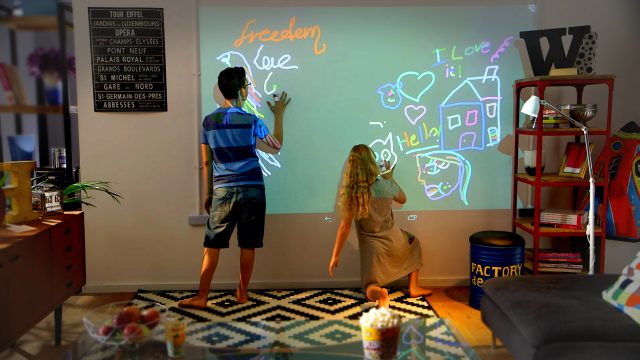
Until we get there, one Israeli startup thinks it has a good interface option: a small plastic shell, laden with sensors, to wear on an index finger.
On Monday, MUV Interactive's new input device—Bird—is set to go on sale to the public for the first time, with a promotional price of $150 for the first 15,000 units. After that, MUV will kick Bird up to its regular price of $250. (As of this writing, online sales are set to begin Tuesday morning at 1am Eastern Time, which appears to be an error.) MUV has already sold over 15,000 units, primarily to business customers.
Once nestled onto the user’s finger, Bird combines with a TV or projector (up to 300 inches), essentially turning it into a massive touchscreen, except with no actual touch. Bird allows the wearer to move his or her hand in space to draw, click, move, or do practically anything else you can do with a touchscreen. The device only comes in at about 20 grams, or about a tenth of what an iPhone 6 weighs.
Using various plugins for its app, Bird can act as a controller for other devices as well like the Philips Hue lamp or even a drone—rather than flying with a phone, the pilot can fly with his or her own hand.
Bird is hardly the first device in this gesture-based input sector. Competitors range from the more established Microsoft Kinect to the newer Nod Ring and the Myo Gesture Control Armband. Analysts from IHS Global Insight told Ars that this market is currently valued at between $10 and $20 million, but use cases have previously been limited largely to TV and gaming.
Rami Parham, MUV’s co-founder and CEO, told Ars that he hopes Bird is used for more. He can envision the device in corporate presentation-style environments, classrooms, and even at home.
"It can seamlessly replace multiple input devices," he said. "It senses that your finger is inside. You have one [sensor] inside and several outside, you have four sensors and you have inertial sensors, and you have some cameras and other sensors embedded within the device that you are not aware of. There are all sending their information to the base unit. [That unit] runs our own algorithms and then provides final commands over Bluetooth to the screen."
In a recent demo held at a rented Airbnb apartment in San Francisco's South of Market neighborhood, Parham showed how Bird can be easily used in various types of work or play spaces. He turned a large projected presentation into a touchscreen-style environment where he could swipe in space to turn a page. And later, in one of the more interesting applications, Parham wore multiple Birds and showcased a very intuitive way to play multiplayer Fruit Ninja.
"Android and iOS can already support more than 10 touch points, but there is no reason to assume that more than one person will touch this screen or tablet, and we just enabled it," the CEO added. "[With Bird] we can have 10 people touching the tablet together." (Parham noted that since he started taking Bird out for demos, he's playedFruit Ninja so often that he can now successfully win blindfolded.)
Ars will be reviewing the MUV Interactive Bird in the coming months.
reader comments
33